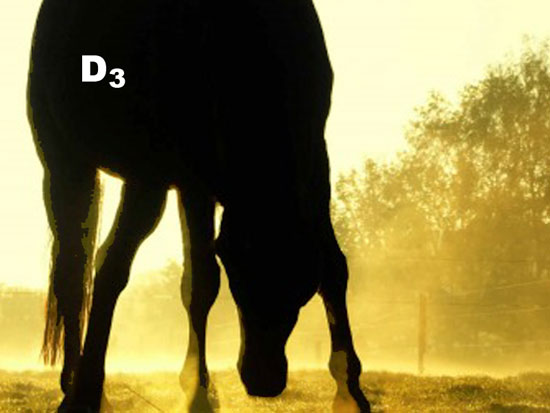April 2013 – Supplying your horse with Vitamin D
This month’s information letter from PC-Horse focuses on vitamin D. Requirements for vitamin D, the contribution of feedstuffs to the horse’s vitamin D intake and the importance of storage losses are all discussed. The article is written by Dr. Dag Austbø of the Norwegian University of Life Sciences.
Drs. Dag Austbø and Knut Hove are two of the key people behind the development of PC-Horse. Their scientific work and international networks contribute to the biological basis and computational models used in PC-Horse.

Vitamin D plays a key role in regulating the stores of calcium and phosphorus in the body by controlling the absorption of these minerals from the intestine. When experiencing a deficiency of vitamin D young horses will absorb too little calcium and phosphorus to enable building of well mineralized, healthy bones, even when the ration contains adequate amounts of the minerals. In severe vitamin D deficiency, rickets will develop. In addition to its effects on mineral metabolism and bone, we now know that vitamin D has significance for the normal functioning of the immune system and a variety of cell functions. Along with vitamin A and E, Vitamin D is one of the group of fat-soluble vitamins and because it is fat-soluble, vitamin D reserves can be stored in body fat for several months.
Plant material may contain Vitamin D2 (Ergocalciferol), while animals produce Vitamin D3 (Cholecalciferol). Both forms of vitamin D are effective in mammals, and we therefore use the generic term "Vitamin D" when talking jointly about the two forms. Vitamin D is converted to the biologically active form 1,25(OH)2 D through several chemical stages before it can exert its effects in the body.
Vitamin D3 is formed in the skin of mammals during exposure to sunlight. Horses which are kept outside will make adequate amounts of vitamin D in the summer, and may build up reserves for several months. In areas with long winters and little sunlight (Northern Europe, Scandinavia), however, these reserves will not last throughout the winter season, and it is important that the requirement for vitamin D is met from the diet.
The content of vitamin D in a feed is usually expressed in international units (IU). One international unit is equivalent to 25 nanograms of the vitamin. NRC 2007 defines a minimum requirement of 6.6 IU per kg body weight for adult horses regardless of exercise level, pregnancy or lactation. Higher requirements are defined for young growing horses. For age between 0-6 months, NRC recommends 22.2 IU per kg body weight, decreasing with age to 13.7 IU per kg body weight by 19-24 months. It is important to note that these recommendations are for the minimum required intake of vitamin D. In PC-Horse, we've increased that minimum by about 20% to provide a safety margin for situations where the horse gets little sunlight.
Most grasses and grains contain relatively little vitamin D when harvested. As mentioned, direct sunlight will initiate photochemical reactions which increase vitamin D content. When grass is dried in the sun after cutting, hay with about 1000 IU vitamin D per kg will be produced. In wilted haylage with a dry matter content of 60% we can expect an average vitamin D content of 500-800 IU per kg dry matter. The vitamin D content will, however, be variable and will be affected by the weather during drying, the number of times the grass is turned before it is dry and the overall length of the drying period. Vitamin D content in hay and haylage reduces during storage.
Most concentrates used for horses contain added vitamin D3, usually in amounts of about 800-1200 IU per kg. Many feed supplements contain vitamin D3, and the amounts vary widely. Vitamin D is toxic in large amounts and can cause serious disorders of calcium and phosphorus metabolism. In the PC-Horse program, you will get a warning when the intake of vitamin D is clearly larger than what the horse needs. Usually it takes a long period, typically months, with excessive intake, before any symptoms of poisoning show up.

















